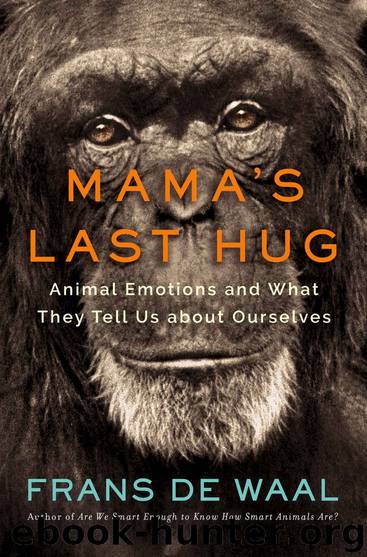Mama's Last Hug: Animal and Human Emotions by Frans De Waal

Author:Frans De Waal [De Waal, Frans]
Language: eng
Format: azw3
Tags: Epub3
Publisher: W. W. Norton & Company
Published: 2019-03-11T16:00:00+00:00
Emotions Are Like Organs
Let me start off with a radical proposal: emotions are like organs. They are all needed, and we share them all with other mammals.
When it comes to organs, this is obvious. No one would argue that some organs are fundamental, such as the heart, brain, and lungs, whereas others are less needed, such as the pancreas and kidneys. Anyone who has ever had a problem with their pancreas or kidneys knows that each and every organ in our body is indispensable. Moreover, our organs don’t fundamentally differ from those of rats, monkeys, dogs, and other mammals. But I wouldn’t even limit it to mammals. Apart from mammary glands, which set Mammalia apart, all organs are shared across the vertebrates, including frogs and birds. I dissected many a frog as a student, and they have everything, including reproductive organs, kidneys, a liver, heart, and so on. The vertebrate body requires a certain machinery, and if any part is missing or failing, it dies.
Regarding the emotions, though, the thinking is patently different. Humans are thought to have only a few “basic” or “primary” emotions, which are essential for survival. The number varies by scientist, running anywhere from two to eighteen, but usually it’s around half a dozen. The obvious basic emotions are fear and anger, but there’s also arrogance, courage, and contempt. The idea that some emotions are more basic than others goes back to Aristotle and has been elevated to a theory, known as Basic Emotion Theory (BET). For an emotion to be counted as “basic,” it must be expressed and recognized by humans all over the world and be hard-wired—a way of calling it inborn. Basic emotions are biologically primitive and shared with other species.42
Human emotions that lack stereotypical expressions, on the other hand, are known as “secondary” or even “tertiary.” They enrich our lives, but we can manage without them—we’d still be fine. They are moreover entirely our own and vary by culture. The list of proposed secondary emotions is quite lengthy, but as you will have noticed, I take issue with the entire proposal that they even exist. It’s as flawed as would be the idea that not every organ in our body is essential. Even the appendix (the blind-ended little tube connected to the cecum) is not called “redundant” or “vestigial” anymore, because it has evolved independently so many times that its survival value is not in doubt. Its probable function is to harbor good bacteria, which help reboot the digestive tract, for example, after a severe case of cholera or dysentery. In the same way that every part of our body has its purpose, every emotion evolved for a reason.
First, as we have seen here for pride, shame, guilt, revenge, gratefulness, forgiveness, hope, and disgust, we can’t exclude their presence in other species. These emotions may be more developed in us, or they may be used under a wider range of circumstances, but they aren’t fundamentally new. That some human cultures emphasize some of them more than others hardly argues against a biological origin.
Download
This site does not store any files on its server. We only index and link to content provided by other sites. Please contact the content providers to delete copyright contents if any and email us, we'll remove relevant links or contents immediately.
Sapiens: A Brief History of Humankind by Yuval Noah Harari(13078)
The Tidewater Tales by John Barth(12039)
Do No Harm Stories of Life, Death and Brain Surgery by Henry Marsh(6343)
Mastermind: How to Think Like Sherlock Holmes by Maria Konnikova(6252)
The Thirst by Nesbo Jo(5795)
Why We Sleep: Unlocking the Power of Sleep and Dreams by Matthew Walker(5659)
Sapiens by Yuval Noah Harari(4553)
Life 3.0: Being Human in the Age of Artificial Intelligence by Tegmark Max(4521)
The Longevity Diet by Valter Longo(4454)
The Rules Do Not Apply by Ariel Levy(3915)
The Immortal Life of Henrietta Lacks by Rebecca Skloot(3833)
The Body: A Guide for Occupants by Bill Bryson(3818)
Why We Sleep by Matthew Walker(3782)
Animal Frequency by Melissa Alvarez(3762)
Yoga Anatomy by Kaminoff Leslie(3712)
Barron's AP Biology by Goldberg M.S. Deborah T(3636)
The Hacking of the American Mind by Robert H. Lustig(3588)
All Creatures Great and Small by James Herriot(3527)
Yoga Anatomy by Leslie Kaminoff & Amy Matthews(3406)
